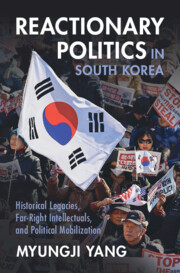Refine search
Actions for selected content:
356 results
2 - Corporations as Agents of Socioeconomic Change
- from Part I - The Landscape
-
- Book:
- Corporate Power and the Politics of Change
- Published online:
- 17 December 2025
- Print publication:
- 18 December 2025, pp 68-92
-
- Chapter
- Export citation

Reactionary Politics in South Korea
- Historical Legacies, Far-Right Intellectuals, and Political Mobilization
-
- Published online:
- 17 December 2025
- Print publication:
- 18 December 2025
Why did the Netherlands apologize? Slavery, justice, and the political conditions of state apologies in Europe
-
- Journal:
- Review of International Studies , First View
- Published online by Cambridge University Press:
- 15 December 2025, pp. 1-21
-
- Article
-
- You have access
- Open access
- HTML
- Export citation
Public revolutionaries, private conservatives: rock performances of leftist political thought
-
- Journal:
- Popular Music , First View
- Published online by Cambridge University Press:
- 28 November 2025, pp. 1-16
-
- Article
-
- You have access
- Open access
- HTML
- Export citation
Rooting Equality: Testing the Effectiveness of Activist Frames Combating Homophobia in Zimbabwe
-
- Journal:
- British Journal of Political Science / Volume 55 / 2025
- Published online by Cambridge University Press:
- 27 November 2025, e170
-
- Article
-
- You have access
- Open access
- HTML
- Export citation
A decolonial archaeology of refusal, care and repair
-
- Journal:
- Antiquity , First View
- Published online by Cambridge University Press:
- 24 November 2025, pp. 1-12
-
- Article
-
- You have access
- Open access
- HTML
- Export citation
Compassionate Cites and Compassionate Communities: A Critical Interpretative Review
-
- Journal:
- Social Policy and Society , First View
- Published online by Cambridge University Press:
- 20 November 2025, pp. 1-20
-
- Article
-
- You have access
- Open access
- HTML
- Export citation
Winning the Eight-Hour Day in Australia: A Social-Movement Explanation for a Precocious Success
-
- Journal:
- International Labor and Working-Class History , First View
- Published online by Cambridge University Press:
- 06 November 2025, pp. 1-20
-
- Article
-
- You have access
- Open access
- HTML
- Export citation
The promises and tensions of socio-legal participatory action research
-
- Journal:
- International Journal of Law in Context / Volume 21 / Issue 4 / December 2025
- Published online by Cambridge University Press:
- 03 November 2025, pp. 560-575
-
- Article
-
- You have access
- Open access
- HTML
- Export citation
4 - Labor, Gender, and Civil Society Mobilization
- from Part II - Politics from Below
-
- Book:
- Democracy and Inequality in India
- Published online:
- 11 October 2025
- Print publication:
- 30 October 2025, pp 136-198
-
- Chapter
- Export citation

Pious Politics
- Cultural Foundations of the Islamist Movement in Turkey
-
- Published online:
- 21 October 2025
- Print publication:
- 30 October 2025
Adoption and Implementation as a Two-Stage Process: Feminist Strategies and Conservative Resistance in the Quest for Legislative Abortion Reform
-
- Journal:
- Perspectives on Politics , First View
- Published online by Cambridge University Press:
- 20 October 2025, pp. 1-21
-
- Article
-
- You have access
- Open access
- HTML
- Export citation
Conclusion
-
- Book:
- Risk and Resistance
- Published online:
- 10 September 2025
- Print publication:
- 09 October 2025, pp 145-151
-
- Chapter
- Export citation
3 - Structural Inequality and the Evolving Movements for Land-Use Justice
-
-
- Book:
- Racial Justice in American Land Use
- Published online:
- 19 September 2025
- Print publication:
- 09 October 2025, pp 69-98
-
- Chapter
- Export citation
“Revolution” as Restoration: Woman, Life, Freedom in the Diasporic Imaginary
-
- Journal:
- Iranian Studies ,
- Published online by Cambridge University Press:
- 07 October 2025, pp. 1-7
-
- Article
-
- You have access
- Open access
- HTML
- Export citation
4 - Re-presenting Rights
-
-
- Book:
- Reckoning with Law in Excess
- Published online:
- 09 September 2025
- Print publication:
- 25 September 2025, pp 96-119
-
- Chapter
-
- You have access
- Open access
- HTML
- Export citation
8 - Plurinational Juristocracy and Rights from Below at Bolivia’s Gas Frontier
-
-
- Book:
- Reckoning with Law in Excess
- Published online:
- 09 September 2025
- Print publication:
- 25 September 2025, pp 186-211
-
- Chapter
-
- You have access
- Open access
- HTML
- Export citation
Women, Feminism, and the Construction of Collective Memory: Community-Based Memory Projects in Postconflict Colombia: The Case of Medellín
-
- Journal:
- Latin American Research Review ,
- Published online by Cambridge University Press:
- 22 September 2025, pp. 1-23
-
- Article
-
- You have access
- Open access
- HTML
- Export citation

Risk and Resistance
- How Feminists Transformed the Law and Science of AIDS
-
- Published online:
- 10 September 2025
- Print publication:
- 09 October 2025

From Manners to Rules
- Advocating for Legalism in South Korea and Japan
-
- Published online:
- 29 August 2025
- Print publication:
- 07 August 2025
